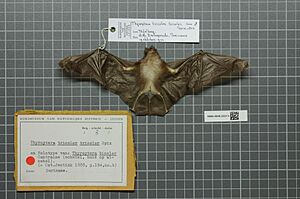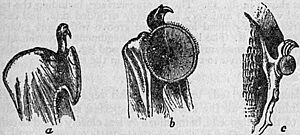Spix's disk-winged bat facts for kids
Quick facts for kids Spix's disk-winged bat |
|
|---|---|
 |
|
| Conservation status | |
| Scientific classification | |
| Genus: |
Thyroptera
|
| Species: |
tricolor
|
 |
|
The Spix's disk-winged bat (Thyroptera tricolor) is a special kind of bat. It lives in the Americas, all the way from Mexico down to Brazil. What makes this bat super unique are the small, round disks on its thumbs and back feet. These disks work like tiny suction cups. They help the bat stick to and move along very smooth surfaces.
Contents
Where Spix's Disk-Winged Bats Live
Spix's disk-winged bats can be found in many countries. These include Venezuela, Tobago, Trinidad, Suriname, Peru, Panama, Mexico, Guyana, Guatemala, Honduras, French Guiana, Costa Rica, Ecuador, Colombia, Brazil, Belize, and Bolivia. Even though they are spread out, they are not found everywhere in these places. The International Union for Conservation of Nature (IUCN) says they are a least-concern species. This means they are not currently in danger of disappearing.
Why Roosting Spots Are Important
The number of these bats might depend on where they can find good places to rest. Most bats can gather in large groups. They hang upside down from cave ceilings or inside hollow trees. But the Spix's disk-winged bat is different. It likes to rest inside rolled-up leaves. So, there need to be enough plants with these special leaves for them to live.
What Spix's Disk-Winged Bats Look Like
Spix's disk-winged bats have a light-colored belly. It can be white or a pale yellow. Their back is usually reddish-brown to black. Female bats are a little bit bigger than males. Their forearm, from elbow to wrist, is about 37 millimetres (1.5 in) long for females. For males, it is about 36 millimetres (1.4 in). An adult bat weighs around 4 grams (0.14 oz). That's about the same as two paper clips!
Most bats hang upside down when they rest. But the Spix's disk-winged bat hangs head-up. Only a few bat species do this. These include the disk-winged bats (like Thyroptera) and the sucker-footed bats (like Myzopoda). Both groups have sticky feet, but they developed them in different ways. This is called parallel evolution.
How Their Suction Cups Work
The disk-winged bat looks for rolled-up leaves that have an opening at the top. Plants like Heliconia and Calathea have these kinds of leaves. The bat then sticks to the smooth inside surface of the leaf, hanging head-up. Resting this way helps them escape quickly if there is danger.
The bat's disks are shaped like small cups. They have a strong, bendy plate inside. A muscle called the flexor pollicis brevis muscle is attached to this plate. When the muscle tightens, it changes the shape of the disk. This creates a suction effect, helping the bat stick. The bat also licks its disks often to keep them clean and moist. This moisture helps the suction work better.
Disk-Winged vs. Sucker-Footed Bats
The Madagascar sucker-footed bat (Myzopoda aurita) has similar sticky feet. But it uses them a bit differently. It uses its muscle to change the disk's shape when it wants to unstick. It also uses sweat to make its feet wet and sticky. This wetness is the main way it sticks, not just suction. The sucker-footed bat can only stick head-up. But the disk-winged bat can stick at any angle.
Bat Behavior
Spix's disk-winged bats live together in groups. A typical group has about six bats. There are usually an equal number of males and females in a group. Their special disks do not stop them from flying well. They can fly around rolled-up leaves before going inside. They usually fly just a few meters above the ground in the forest. These bats eat insects. An adult bat can eat up to 0.8 grams (0.03 oz) of insects in one night.



